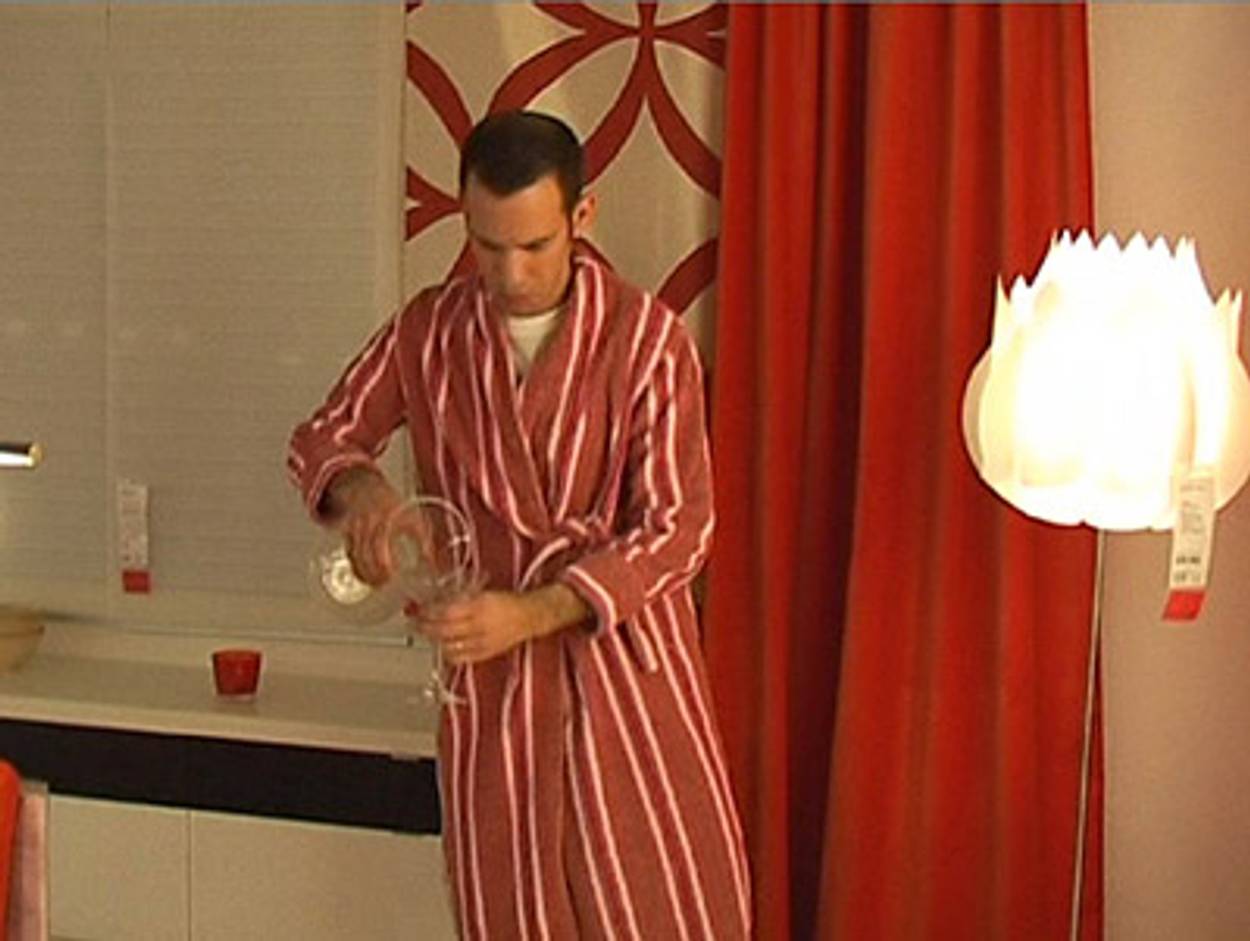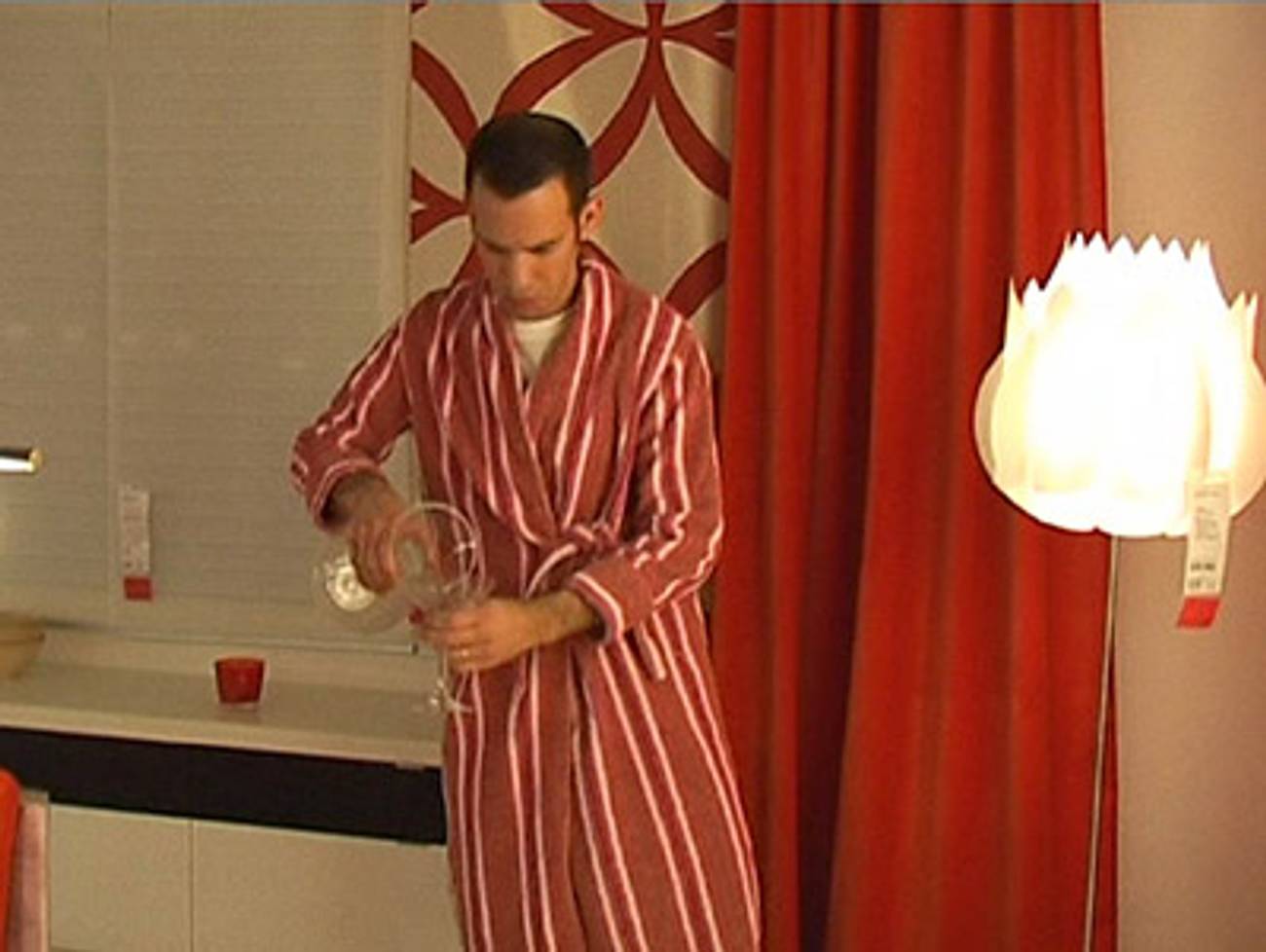Family Guy
The domestic fantasies of Guy Ben-Ner




For the first minute or two of Stealing Beauty, Guy Ben-Ner’s single-channel video currently on view at the Chelsea Art Museum in New York City, the work feels like an ordinary—if rather low-budget—situation comedy. Ben-Ner, lean, dark haired, and looking younger than his thirty-nine years, enters a living room, shouts out, “Honey, I’m home!” and then heads for the shower. His real-life wife, Nava, appears shortly afterwards and begins to good-naturedly hector him. When their two children, eleven-year-old Elia and six-year-old Amir, appear, the stage is set for a typical sitcom episode in which a family conflict arises and is resolved within the half hour.
But the longer you watch Stealing Beauty, which was begun in 2006 and also featured in Ben-Ner’s recent show at Postmasters gallery in New York City, the more you realize something isn’t quite right. Where most sitcoms reinforce the ordinary mechanics of family interaction, Stealing Beauty undermines them. Ben-Ner and his children discuss the origins of the word “family” (from the Roman familia, which meant a household, including slaves), and his daughter reads aloud from Frederick Engels’s The Origin of the Family, Private Property and the State. The artist charges his kids for bedtime stories and homework assistance, and the video climaxes with the children reading a manifesto, chanting, “Children of the world unite! Steal from the state! Steal from your parents! Steal your inheritance!”
Even the setting for the video is odd. Price tags dangle from every fixture and piece of furniture, and people amble through the frame, as though they had every right to inspect the tables and chairs.
There’s a simple explanation for all of this. Stealing Beauty was shot in Ikea stores in New York, Berlin, and Tel Aviv. The tricky part: It was shot without the houseware superstore’s permission.
“We kept getting kicked out,” the Israeli artist says with a laugh. “But it was different in every country. In the United States, you could shoot practically all day, whereas in Germany you had to be very quiet, and in Israel we would get shut down very quickly.”
Ben-Ner’s clever and daring approach to video has been getting quite a bit of attention over the past several years. In 2005 he represented Israel at the fifty-first Venice Biennale, the oldest and one of the most esteemed contemporary art exhibitions in the world. The same year, his work appeared in “Greater New York,” a roundup of emerging contemporary artists at P.S. 1 Contemporary Art Center in Long Island City, and in an exhibition of contemporary video at the Museum of Modern Art.
On one level, the key to Ben-Ner’s success may be the sheer likeability of his work. Unlike early art videos from the 1960s and 1970s, which were notoriously abstruse—boring became the unfortunate common descriptor—his work is ingenious and entertaining; his video pieces are intellectually rigorous, but full of humor and pathos.
“I use fiction to bring out the truth,” Ben-Ner says. “A family making a sitcom in Ikea is like working within a bubble that allows us to say things to each other that we would not be able to say otherwise. I can tell my kids things they might not know: the burdens of having a family, how I feel about them. My children know I’m dependent on them. The relationship is double sided. Parents are usually dependent on their children, but the kids are not generally aware of it.”
Those familiar with Ben-Ner’s work will not be surprised to see his children in the video. Like most children these days, they’ve virtually grown up on video—it’s just that their father is an artist rather than an amateur videographer. Part of what makes Ben-Ner’s work compelling is that he takes vernacular methods of telling stories about the family—the television situation comedy and home video—and brings them into an art setting.
* * *
Ben-Ner didn’t start off as a video artist. His parents were born in Israel, and he was born and raised in Ramat Gan, a small city near Tel Aviv. Before moving to Tel Aviv he went to Hamidrasha Art Teachers School (he had no plans to become a teacher; it’s just the art school he chose). He describes his approach to art-making during those years as “very confused . . . I went through a period where I did everything. I made drawings that looked like Rube Goldberg,” he says. “The thing about the drawings is that they looked like movies. And then what happened is that the stories that I wanted to deal with took control. And when content takes control, you become a slave to the medium. You use whatever you have to tell your story.”
Choosing video came with economic consequences: it isn’t as saleable, for instance, as painting. Ben-Ner has worked as a waiter, and his wife as a nanny, to support the family. Family is the central story in Ben-Ner’s art. In fact, his family members appear in nearly all of his videos. In Moby Dick (2000) he reenacts Melville’s novel in his kitchen; he and Elia play all the roles (Ben-Ner has said that he was particularly attracted to a section of the novel in which Ahab alludes to the wife and child he left back at home). “I was married very young,” he says, “at twenty-four.” Children followed shortly thereafter. “It was an accident,” he says frankly.
In 2001 Ben-Ner and his family made their way from Israel to the United States so he could study at Columbia University. He completed an MFA degree in 2003. “We wanted to get out of Israel for a year or two. I longed for some bordeom,” he jokes. “Political boredom. But really, it was my wife who wanted to leave, not me.”
Attending Columbia, he explains, was the easiest way to get the visa. “The first three years were really tough, economically. We were living in Columbia housing and didn’t have much space, so we had to shoot outside. After I finished at Columbia we went to Queens, then we ended up in Bushwick,” the Brooklyn neighborhood that has become the latest de facto artists’ enclave as rents in Williamsburg have risen.
Two videos made during his New York period showcase his children in their early years. The first, Elia—a story of an ostrich chick (2003), follows the migration of a flock of flightless birds, played by the family dressed up in ungainly ostrich costumes. Ben-Ner was raised in a secular household and encountered Judaism mostly “through school and holidays.” But, with its themes of migration and immigration, Elia has been cited as the “most Jewish” of his videos. “My friend Boaz Arad sees everything before it is done—he edits with me sometimes. He is Israeli and a very good artist,” Ben-Ner says. “He is the one who pointed this out to me, although I didn’t realize it beforehand.”
Wild Boy (2004), the second video, is a paean to his son. In it, Amir plays a feral child who is captured and domesticated. The work includes hilarious touches that pay homage to the father-and-son duo of Joe and Buster Keaton.
References to early cinema pop up frequently in Ben-Ner’s work. Not only does he see Wild Boy as a metaphor for how silent film was tamed by sound, but, he says, “I’ve become more interested in the language of cinema, because early cinema was for me almost like a catalog of conventions.”
There are many similarities between Ben-Ner’s working methods and those of the Keatons, whose home and work environments often blurred together. Budget is another concern. “For someone who has made movies at home, or for $1,000, I felt a particular similarity with the era of silent film,” he explains.
Despite the references to early movies, Ben-Ner also wears his contemporary art influences on his sleeve. One of his biggest inspirations is the Canadian artist and video maker Rodney Graham. Graham, who came of age in the Vancouver postconceptual scene, has described his approach as “annexation” rather than appropriation: He doesn’t just borrow, but adds to or changes things in existing works, essentially taking them over and remaking them. Similarly, Ben-Ner’s video Berkeley’s Island (1999), in which he plays a castaway on an island of sand planted in the middle of a small apartment kitchen (he has described the work as a metaphor for Israel, a nation that functions in its region as a “political island”), refashions the stories of Robinson Crusoe and Graham’s 1997 video Vexation Island (1997) into a work that pays frank homage to both.
Similarly, the last portion of one of his most recent works, I’d give it to you if I could but I borrowed it, is a comical recreation of a Graham video in which the artist took LSD and rode a bicycle through a park in Berlin—itself a recreation of a historic bicycle ride by the chemist who invented LSD, Albert Hofmann. But the Graham section of I’d give it to you wasn’t preplanned. “When I was making the video, I didn’t have a clue I was going to do it. But it didn’t feel finished. The work was dry without the Graham.”
There is an interesting twist here, since, as Ben-Ner puts it, “a lot of my influences I can’t boast about because they didn’t manage to have a career on the international level.” He cites Israeli artists like Michal Neeman and Yair Garbuz. “Neeman made wonderful, clever collages in the ’70s and ’80s, and Garbuz worked mainly in the ’70s and made homemade films that were very inventive. They were both my teachers and influence the way I think more than anything.” But if he referred to them in his videos, “they wouldn’t mean anything to anyone, because they didn’t have careers outside of Israel.”
For Ben-Ner, that doesn’t seem to be a problem. He is part of a wave of Israeli artists gaining attention in the United States, such as Michal Rovner, Tamy Ben-Tor, or Sigalit Landau. (A video featuring Landau, nude, inserted in a coil of strung-together watermelons floating in the Dead Sea, is currently on view in a solo show at MoMA.) Ironically, migration may be partially responsible for his success; Ben-Ner has stated in the past that he feels he would not have been chosen to represent Israel in the Venice Biennale if he had remained there. “Maybe I’m wrong,” he says. “But I feel that it is natural for any place that is off-center—it needs confirmation from the center.”
The migration has continued. In 2006, when Ben-Ner was awarded a DAAD grant, he moved his family to Berlin. There he conceived of Stealing Beauty, as well as I’d give it to you if I could but I borrowed it, which was featured in the Muenster Sculpture Project last summer. Where will they go next? “We might stay in Berlin, or we might go back to Tel Aviv,” Ben-Ner says. “I’m not sure. The children are tired. They don’t want to have to learn another language.”